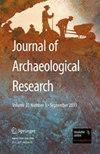Early Complex Society on the North and Central Peruvian Coast: New Archaeological Discoveries and New Insights
IF 4.1
1区 历史学
Q1 ANTHROPOLOGY
引用次数: 0
Abstract
Archaeological data from the north and central Peruvian coast are presented here as a means to explore key themes relating to social complexity, including complex society and its origins, newly resolved chronological issues, the relationship between iconography and society, and the definition of a new culture. Focusing on an early time span, from ca. 3000 to 200 cal BC, we identify key questions about the trajectory through which early Andean complexity developed, and we discuss new ideas about the chronological placement of Cerro Sechín and Chavín de Huántar. We also use an intertextual approach to study the iconography of the complex Sechín Alto polity and as a means to demonstrate duality, social hierarchy, and the origin of symbols within the society’s iconography. Finally, we highlight a newly described polity, centered in the Nepeña Valley, that is important because its urban traits presage later cultural complexity and because the recognition of this polity demonstrates the potential for similar discoveries of comparable small polities.秘鲁北部和中部海岸的早期复杂社会:考古新发现与新见解
本文介绍了秘鲁北部和中部沿海地区的考古数据,以此探讨与社会复杂性相关的关键主题,包括复杂社会及其起源、新解决的年代问题、图像学与社会之间的关系以及新文化的定义。我们将重点放在约公元前 3000 年至公元前 200 年的早期时间跨度上,确定了有关早期安第斯复杂性发展轨迹的关键问题,并讨论了有关 Cerro Sechín 和 Chavín de Huántar 年代位置的新观点。我们还利用互文法研究了复杂的塞钦阿尔托政体的图示,并以此来展示社会图示中的二元性、社会等级和符号起源。最后,我们重点介绍了一个新描述的政体,该政体以内佩尼亚山谷(Nepeña Valley)为中心,其重要性在于它的城市特征预示了后来文化的复杂性,而且对该政体的认识显示了发现类似小政体的可能性。
本文章由计算机程序翻译,如有差异,请以英文原文为准。
求助全文
约1分钟内获得全文
求助全文
来源期刊

Journal of Archaeological Research
Multiple-
CiteScore
10.20
自引率
7.90%
发文量
9
期刊介绍:
Journal of Archaeological Research publishes the most recent international research summaries on a broad range of topics and geographical areas. The articles are intended to present the current state-of-the-discipline in regard to a particular geographic area or specific research topic or theme. This authoritative review journal improves access to the growing body of information and literature through the publication of original critical articles, each in a 25-40 page format.2-Year Impact Factor: 4.056 (2017) 5-Year Impact Factor: 4.512 (2017)2 out of 85 on the Anthropology listIncluded in the European Reference Index for the Humanities (ERIH) PLUS The European Reference Index for the Humanities and the Social Sciences (ERIH PLUS) was created and developed by European researchers under the coordination of the Standing Committee for the Humanities (SCH) of the European Science Foundation (ESF). https://dbh.nsd.uib.no/publiseringskanaler/erihplus/about/indexSCImago Journal and Country Rank (SJR) 2018: 1.7102 out of 263 on the Archeology (Arts and Humanities) list3 out of 254 on the Archeology list2 out of 131 on the General Arts and Humanities listSJR is a measure of the journal’s relative impact in its field, based on its number of citations and number of articles per publication year.Source Normalised Impact per Paper (SNIP) 2018: 2.112The SNIP measures contextual citation impact by weighting citations based on the total number of citations in a subject field. The impact of a single citation is given higher value in subject areas where citations are less likely, and vice versa.CiteScore 2018: 3.86Rated ''A'' in the Australian Research Council Humanities and Creative Arts Journal List. For more information, visit: http://www.arc.gov.au/era/journal_list.htm
SCImago Journal and Country Rank (SJR) 2011 1.227 Archeology 1 out of 96 Archeology (Arts and Humanities) 1 out of 59 Arts and Humanities (miscellaneous) 1 out of 243
 求助内容:
求助内容: 应助结果提醒方式:
应助结果提醒方式:


